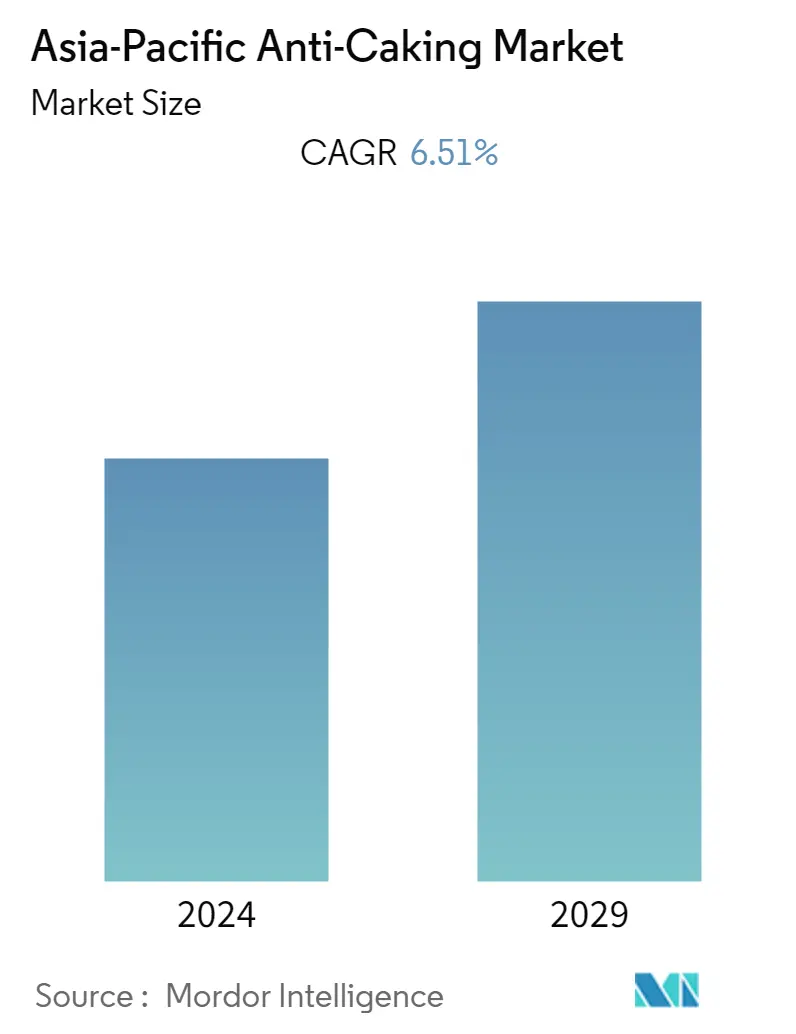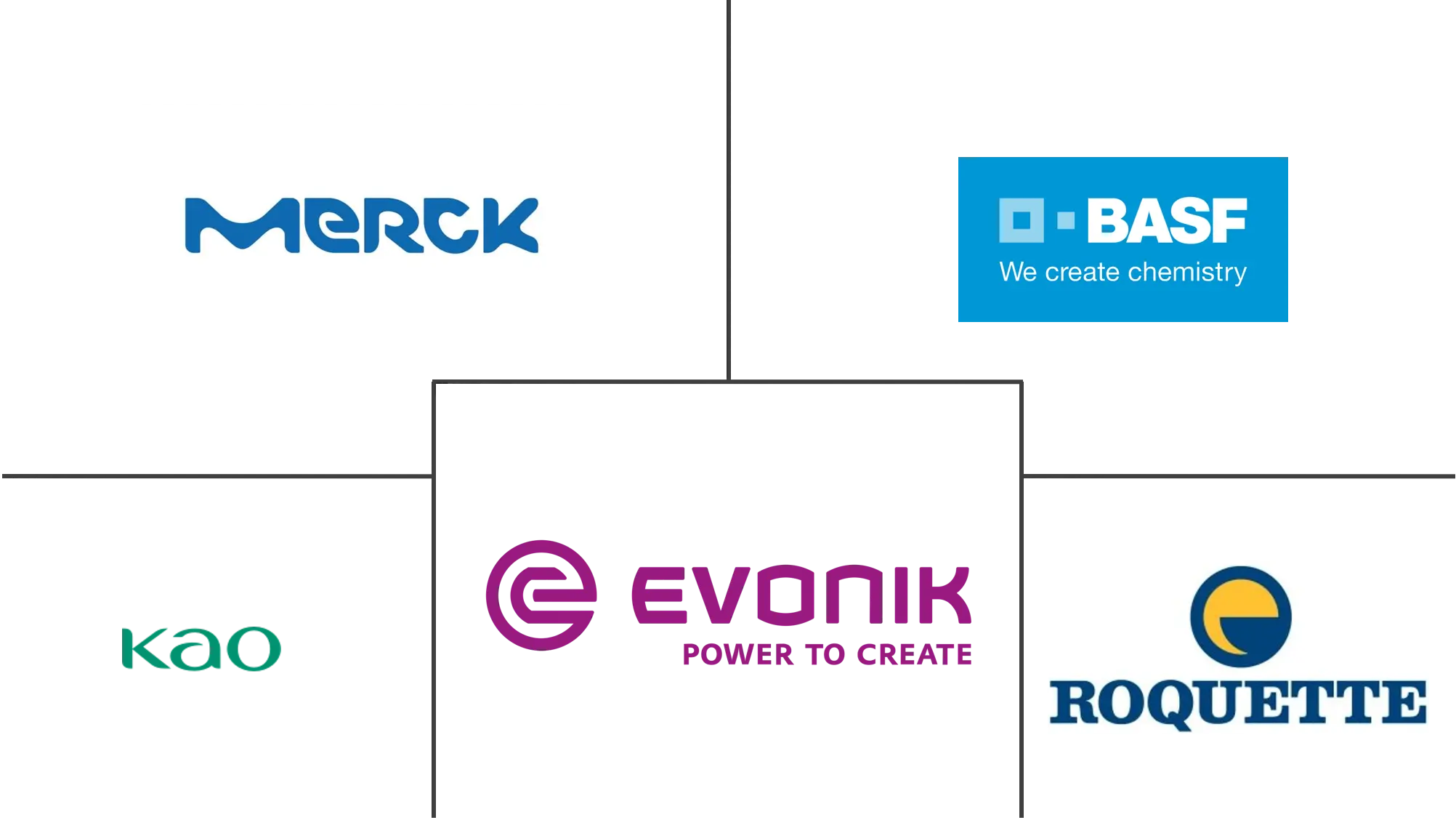Market Size of Asia-Pacific Anti-Caking Industry

| Study Period | 2019 - 2029 |
| Base Year For Estimation | 2023 |
| Forecast Data Period | 2024 - 2029 |
| Historical Data Period | 2019 - 2022 |
| CAGR | 6.51 % |
| Market Concentration | Low |
Major Players
*Disclaimer: Major Players sorted in no particular order |
Asia-Pacific Anti Caking Market Analysis
Asia-Pacific anti caking market is projected to grow at a CAGR of 6.51% during the forecast period.
- Owing to the multi-functional attributes of anti-caking such as facilitating free-flow, texture, and organoleptic properties, the additive has been gaining popularity across, industry with food portraying most promising scope in the forecast period. Natural anti-caking agents such as calcium carbonate and magnesium carbonate have extremely high costs and hence synthetic agents face higher demand.
- By application, animal feed holds the largest share, owing to its heavy volume sales recorded when compared to any other applications.
Asia-Pacific Anti Caking Industry Segmentation
Asia-Pacific anti caking market by type is segmented into calcium compounds, sodium compounds, magnesium compounds, and others. The study also includes revenue generated through food and beverage, cosmetic and personal care, feed, and others. By geography, the market covers economies like China, Japan, India, Australia, and Rest of Asia-pacific.
| Type | |
| Calcium Compounds | |
| Sodium Compounds | |
| Magnesium Compounds | |
| Others |
| Application | |||||||
| |||||||
| Cosmetic and Personal Care | |||||||
| Feed | |||||||
| Others |
| Geography | |
| China | |
| Japan | |
| India | |
| Australia | |
| Rest of Asia-Pacific |
Asia-Pacific Anti-Caking Market Size Summary
The Asia-Pacific anti-caking market is experiencing significant growth, driven by the increasing demand for additives that enhance free-flow, texture, and organoleptic properties, particularly in the food industry. The market is characterized by a preference for synthetic anti-caking agents due to the high costs associated with natural alternatives like calcium and magnesium carbonate. The animal feed sector holds the largest market share, attributed to its substantial sales volume. The bakery industry is also witnessing a rising demand for anti-caking agents, especially with the availability of customized ingredients that require moisture control. Key players, such as BASF SE, are expanding their product offerings to tap into the lucrative indulgent baking segment.
China stands out as the largest market for food anti-caking agents in the Asia-Pacific region, fueled by the growing popularity of convenience foods and processed products. The market landscape is becoming increasingly competitive with the entry of foreign players, who leverage their financial strength, research and development capabilities, and marketing prowess. However, traditional Chinese culinary practices continue to influence consumer preferences. The market is highly fragmented, with numerous unorganized suppliers, while major companies like BASF, Merck, Kao Corporation, and Roquette Frères dominate the scene. These companies are engaging in mergers and acquisitions to expand their portfolios and strengthen their market presence, particularly in China, where production consolidation is a key focus.
Asia-Pacific Anti-Caking Market Size - Table of Contents
-
1. MARKET DYNAMICS
-
1.1 Market Drivers
-
1.2 Market Restraints
-
1.3 Industry Attractiveness - Porter's Five Forces Analysis
-
1.3.1 Threat of New Entrants
-
1.3.2 Bargaining Power of Buyers/Consumers
-
1.3.3 Bargaining Power of Suppliers
-
1.3.4 Threat of Substitute Products
-
1.3.5 Intensity of Competitive Rivalry
-
-
-
2. MARKET SEGMENTATION
-
2.1 Type
-
2.1.1 Calcium Compounds
-
2.1.2 Sodium Compounds
-
2.1.3 Magnesium Compounds
-
2.1.4 Others
-
-
2.2 Application
-
2.2.1 Food and Beverage
-
2.2.1.1 Bakery Products
-
2.2.1.2 Dairy Products
-
2.2.1.3 Soups & Sauces
-
2.2.1.4 Beverages
-
2.2.1.5 Others
-
-
2.2.2 Cosmetic and Personal Care
-
2.2.3 Feed
-
2.2.4 Others
-
-
2.3 Geography
-
2.3.1 China
-
2.3.2 Japan
-
2.3.3 India
-
2.3.4 Australia
-
2.3.5 Rest of Asia-Pacific
-
-
Asia-Pacific Anti-Caking Market Size FAQs
What is the current Asia-Pacific Anti-Caking Market size?
The Asia-Pacific Anti-Caking Market is projected to register a CAGR of 6.51% during the forecast period (2024-2029)
Who are the key players in Asia-Pacific Anti-Caking Market?
Merck KGaA , BASF SE , Kao Corporation and Roquette Frères are the major companies operating in the Asia-Pacific Anti-Caking Market.

